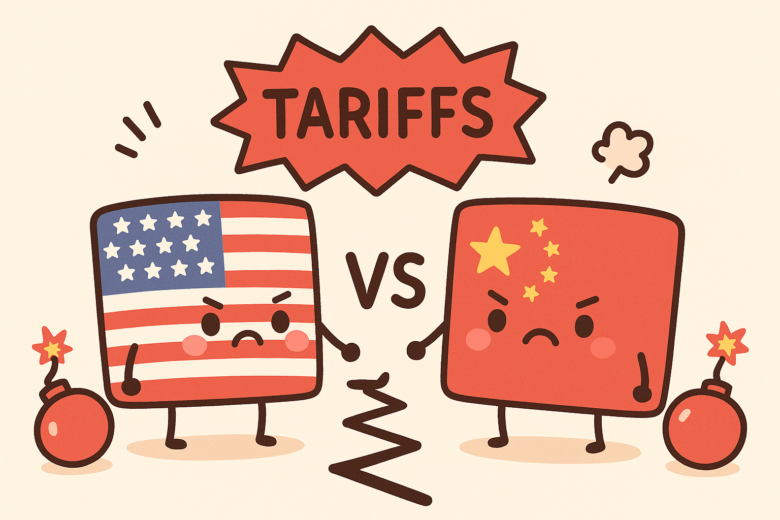What’s up with the market whiplash these days? One day, prices are soaring because of geopolitical fear; the next, they crash on hopes of a truce. It’s confusing, it’s noisy, and it’s still mostly centered around the ongoing trade struggle between the U.S. and China.
Over the past few days, financial headlines highlighted a fresh round of aggressive tariffs threats and counter-threats. While the U.S. and China are set to meet soon for talks, their actions this week suggest the trade war is shifting into a higher, more technologically intense gear.
As a beginner trader, you need to cut through the noise and understand the core concept: What is the latest fight about, and how did it cause assets like gold to plunge just days after hitting a record high?
Here is the simple breakdown of the latest escalation and what it means for your trading decisions.
What Happened This Week?
The U.S.-China trade war isn’t just about tariffs anymore; it’s a battle for technological supremacy, and this week was marked by two significant counter-punches centered on critical resources.
The Trigger: Rare Earths (Early October)
The initial source of tension came from China, which dominates the global supply of crucial inputs, expanded its export controls on rare earth metals and related technology.
While these elements are not exactly “rare” compared to diamonds, they are essential components for everything from smartphones and electric vehicle batteries to advanced military equipment. By restricting their export activity, China signaled it was willing to use its economic leverage to punch back in the trade fight.
The Retaliation: Tariffs and Software (October 20–22, 2025)
The U.S. response came quickly, with two powerful threats from the Trump administration both slated to take effect around November 1, 2025.
A 100% Tariff Threat: The biggest headline was the threatened imposition of an additional 100% tariff on Chinese goods. This would be added on top of existing tariffs, potentially raising the total duty on some imports to 140% or more.
The Software Blockade: This week’s core development was the news that the U.S. administration is actively drafting plans to restrict the global export of products made with or containing U.S. software. Because almost “everything imaginable” relies on American software, from laptops to commercial jet engines, this move would be a massive escalation and severely disrupt global supply chains.
On one side, the U.S. administration, aiming to use tariffs and technological export controls to reduce the trade deficit and push for “reciprocal” trade. On the other, the Chinese government, using its control over key manufacturing inputs, like rare earths, as a powerful counter-tool.
Why It Matters
The real-time market reaction this week perfectly illustrates how geopolitical sentiment drives volatility, especially in safe-haven assets.
The key fundamental driver behind the market’s swings was the conflict between the fear of escalation (tariffs/software ban) and the hope for de-escalation (a potential truce at the upcoming APEC meeting in South Korea).
Market Reaction:
Gold (XAU/USD) Plunged: After reaching an all-time high of over $4,380 per ounce on Monday, October 20th, it experienced a massive correction. On Tuesday, October 21st, Gold prices plunged 5%—one of the sharpest single-day drops since 2020.
This reversal was fueled by signals from President Trump that he was optimistic about striking a “fair” deal soon, overriding the fear of the 100% tariff threat.
Global Equities: Stock markets often react poorly to trade war threats due to the uncertainty they create for corporate profits. However, the optimism about the upcoming meeting acted as a strong counter-force, keeping major indices from collapsing despite the aggressive threats.
Key Lessons for Traders
The events of this week offer several important lessons for anyone navigating the markets:
1. Geopolitical Hope Can Override Geopolitical Fear in an Instant
Markets often price in the worst-case scenario. When there’s even a slight hint that the worst won’t likely happen, the fear premium evaporates rapidly.
Why It Matters: Gold’s 5% crash was not caused by an economic report, it was caused by one optimistic quote about a meeting. As a trader, you must recognize that political rhetoric, especially surrounding trade talks, can trigger sudden violent reversals in safe-haven assets.
2. The Core Fight is Now About Technology and Supply Chains
Modern trade wars target high-value inputs, not just consumer goods.
Why It Matters: The focus on rare earths and U.S. software shows that the fight is about who controls the technology of the future. This is critical for traders because it makes the tech and industrial sectors highly sensitive to any trade news. Watch companies reliant on these specific inputs.
3. Know Your Currency Pair’s Political Sensitivity
The USD/CNH pair is a direct gauge of U.S.-China sentiment.
Why It Matters: Trading USD/CNH requires understanding that Beijing actively manages the CNH’s stability. While aggressive U.S. threats tend to push the pair higher (weaker yuan), the political desire for a stable exchange rate before talks can keep it rangebound.
THE BOTTOM LINE
This week reinforced that the U.S.-China conflict is an escalating technological trade war that drives sharp, sentiment-based volatility. The 100% tariff threat and the proposed U.S. software blockade are the two biggest levers currently being pulled.
For market players, the most important event to watch now is the upcoming meeting between President Trump and President Xi in South Korea. The rhetoric surrounding that event will determine if the recent gold selloff turns into a trend or just a temporary pause before new highs.
Remember that in a market driven by sudden geopolitical shifts, risk management is your best tool. Keep your position sizes small, and never assume that a trend (like gold’s recent rally) will continue indefinitely when high-stakes political talks are looming.

